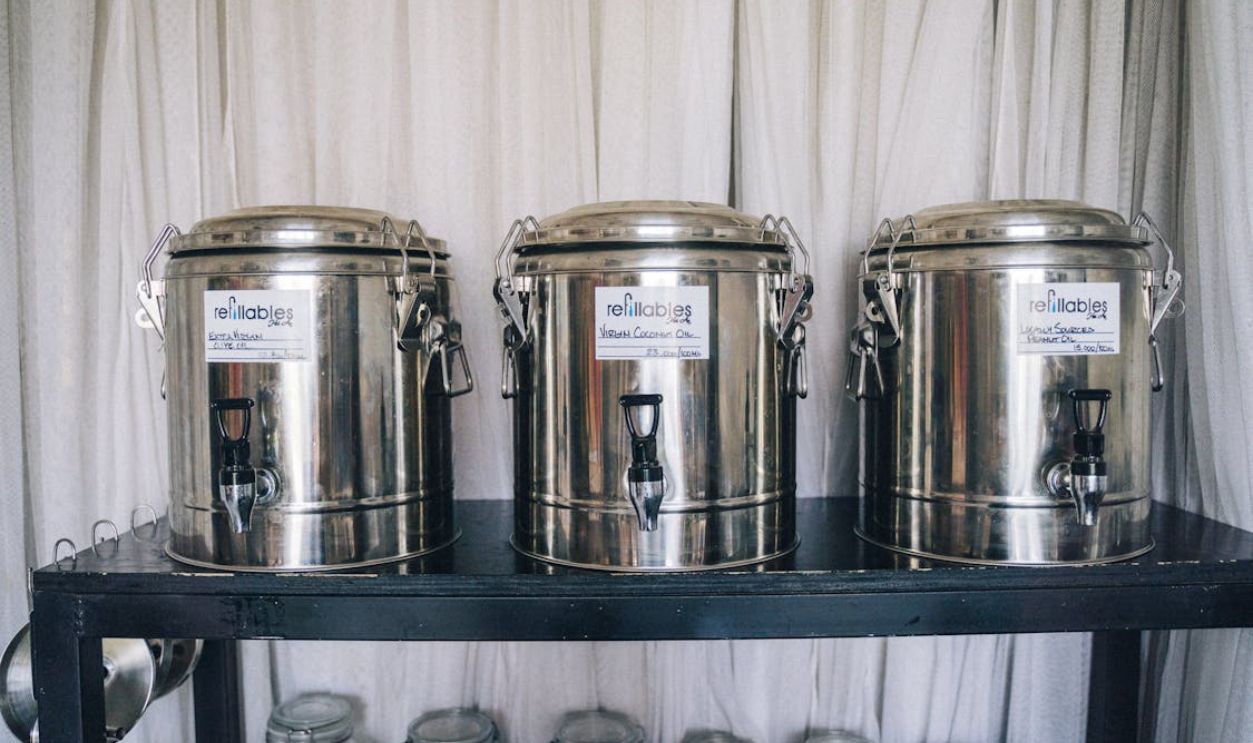Spend Wisely And Eat Nicely
Grocery shopping shouldn’t always be expensive. Actions like smart shopping, meal planning, and substitution hacks can change those grocery trips from budget busters into money-saving victories. Here’s how.

Set A Strict Budget
Before you even step foot in the store, set a realistic grocery budget. This will let you make intentional purchases and avoid those random splurges that add up. Use an app like YNAB or EveryDollar to track your spending. Then, stick to your budget and see some serious savings.
Create A Detailed Shopping List
Making a shopping list is helpful for everyone. Write down what you need to prevent impulse buys. Planning ahead will let you stay on track, and you will end up with only what you need. Moreover, it keeps you focused and efficient during shopping.
Buy Non-Perishables In Bulk
Bulk buying is a huge money-saver. So, stock up on all non-perishable foods like pasta, rice, and canned goods like beans. But make sure you have the storage space and note their expiry dates. Bulk buying reduces packaging waste and the frequency of shop visits.
Shop At Farmer’s Markets
Don’t you just love that organic smell? Well, the best place to get that is at farmers’ markets. Here, you get fresh, locally grown produce at lower prices. The fruits and veggies might not be perfectly shaped, but they can taste really good—sometimes at a fraction of the price.
Check Unit Costs
Unit prices (price per ounce, pound, etc.) are your best friend when it comes to finding the right deals. Always check them to compare packaged brands and sizes. Larger packages are often more cost-effective, but not always. It’s wise to compare to get the most bang for your buck.
Use Digital Coupons And Apps
Say goodbye to clipping paper coupons and hello to digital ones. Thankfully, many grocery shops offer digital coupons that you can load onto your phone or loyalty card. There are also apps that show you where the best deals are. Use these to save a ton.
Shop Early For Discounts
Timing is everything. Shopping early in the morning or late at night often means you can grab clearance items or end-of-day discounts. Stores mark down products that are near their expiration dates, so you can score great deals for things you use pretty quickly.
Skip Pre-Packaged Produce
Pre-packaged produce may look convenient since you’re paying for the effort and that packaging. However, it’s not much work to simply buy intact fruits and veggies and chop them yourself. Also, you get more control over freshness and portions.
Buy Whole Cuts Of Meat
Whole cuts of meat (like a whole chicken or a large pork loin) are much cheaper than pre-cut portions. These go a long way to help you stretch one cut into several meals. Sure, it’ll take a little more effort, but the savings are worth it.
Choose Powdered Milk Alternatives
If you use milk regularly, consider switching to powdered milk or shelf-stable milk. These alternatives do last longer and often cost less than fresh milk. The powdered form is also perfect for pantry storage when you find yourself running low at the last minute.
Buy Staples From Generic Brands
Let’s face it—big brands aren’t always necessary. Generic foods might taste the same and at a much lower price. From canned goods to cleaning supplies, you can swap out a lot of brand-name products after checking the generic items’ labels for quality.
Stock Up On Sale Items
Holiday and festive sales are the holy grail of grocery shopping; spoil yourself. When your favorite ingredients go on sale, make space for products you use frequently and stock them up. You can save money in the future when prices are back up.
Track Pricing Trends
Prices fluctuate, and when you know the right time to buy, it can make all the difference. Start tracking the prices of key foods like eggs, bread, dairy, and sometimes fruits. You’ll notice trends and be able to buy when prices are lowest.
Purchase Frozen Seafood Products
Frozen seafood offers a more affordable alternative than the fresh ones. Along with the nutritional benefits, it lasts much longer in your freezer. Plus the options are just as wide—fish fillets, shrimp, and shellfish. Regardless, always go for the ones recently stocked up as they will offer longer stay.
Never Shop Hungry
Shopping on an empty tummy is a recipe for overspending. When hunger strikes, the impulse to grab snacks and treats increases, often leading to unnecessary purchases. Make sure to eat before you head to the store because it keeps your grocery bill in check.
Never Buy Single-Serve Snacks
Single-serve snacks may seem convenient, but they often cost more than buying in bulk. Skip those individually packaged items and go for larger packages of snacks that you can portion out yourself and save the rest for later. This simple shift saves you a lot over time.
Avoid Convenience Store Shopping
Convenience stores charge a premium for basic groceries. It might be cents on top, but that, too, accumulates. It’s wiser to stick to larger outlets. You might have to travel a bit further, but the savings will make it worth it.
Invest In Reusable Grocery Bags
If you are always buying grocery bags whenever you shop, you are spending more than you should. Sure, it might seem insignificant, if you calculate how much you spend on them monthly, you’ll be shocked. The remedy? Bring your own reusable bags.
Go For Discount Retailers
There are discount grocery stores like Aldi, Lidl, and Walmart that often have lower prices than your typical chain stores. It’s possible that you might not find all your favorite brands, but the quality is generally great, and the savings are undeniable.
 Walmart Corporate, CC BY 2.0, Wikimedia Commons
Walmart Corporate, CC BY 2.0, Wikimedia Commons
Batch Cook And Freeze Meals
Cooking in bulk is a trick meal prep experts use to save money and time. You can prepare big batches of soups, stews, or casseroles and freeze portions for future meals. Besides saving resources, you also reduce food waste. This also helps you avoid ordering takeout when you’re too tired.
Make Homemade Snacks And Treats
Homemade snacks are far more money-saving than most perceive it to be. Plus the options in customization are crazy; your granola can have all the seeds, dried fruits, nuts you always miss on commercially packed ones. You also gain culinary control—a win for both your wallet and your health.
Go Meatless Once A Week
Meat can be expensive, so consider going meatless one or two days a week. Beans, lentils, and tofu are affordable protein alternatives that are quite fulfilling and healthy. Such a simple effort to cut costs adds some variety to your meals.
Avoid Buying Bottled Water
Instead of buying new bottled water, invest in a reusable water bottle and a water filter. Bottled water is expensive, and the environmental impact isn’t great either. With a certified, high-quality filter, tap water can be safe and refreshing to drink.
Preserve Herbs By Drying
Herbs generally have a higher price than other foods, so don’t throw them away when they lose their green. Instead, dry them out and store them for later use. This method extends their shelf life and saves you money on always buying fresh herbs you might not use in time.
Shop Alone To Prevent Distractions
Shopping with others can lead to impulse buys, especially if you’ve got kids or friends along. The remedy is to shop solo to stay focused and stick to your list. You will avoid adding extra picks to your cart and keep your spending in check.
Plan Meals With Overlapping Ingredients
Meal planning is a smooth breeze with intentionality, such as using overlapping ingredients for multiple meals. For example, buy a bunch of spinach for salads, sandwiches, and smoothies, or use leftover chicken in tacos and stir-fries. It helps minimize waste and cost.
Create Meals Based On Current Sales
You can also plan your meals using discounted ingredients to maximize savings. For example, if chicken thighs or bell peppers are on sale, build your weekly menu around those ingredients. The best sources are usually weekly sales flyers, digital coupons, or store apps.
Use Refillable Storage Containers
Rather than buying single-use plastic bags or containers, invest in refillable ones. These come in handy, whether for storing leftovers, bulk-buying grains, or packing lunches. Just like reusable bags, reusable containers save you money and reduce waste.
Check Top And Bottom Shelves
Don’t just grab things that are at eye level because that is usually a marketing ploy. If you are keen, you’ll notice the best deals are on the top or bottom shelves. Retailers place higher-margin products at eye level, so you go for that.
Grow Your Own Vegetables
Did you know that homegrown produce is often cheaper and can taste way better than store-bought options? If you’ve got the space, why not grow your own veggies? Even a tiny herb garden on your windowsill can significantly cut your expenses on fresh herbs.
Make DIY Cleaning Solutions
Skip the fancy (and overpriced) cleaning products, as there are many other alternatives. You can make effective, budget-friendly cleaning solutions with ingredients like vinegar, baking soda, and lemon. They are easy to prepare, eco-friendly, and much cheaper than buying commercial cleaners.
Barter With Neighbors For Produce
Have you got some extra zucchini or tomatoes in your produce? If so, swap them with a neighbor who’s growing something else in their yard. Bartering is a great way to get fresh produce without spending a dime, and it also builds community ties.
Use Powdered Or Concentrated Products
Powdered and concentrated juice products often cost less than their ready-to-use counterparts. They last longer, are more economical, and you can adjust the portion sizes as needed. This way, you only make what you need to drink.
Freeze Leftovers And Surplus Food
Are there any leftovers or surplus produce that you won’t use in time? Freeze it. Freezing increases the shelf life of most foods, from bread and meats to fruits and vegetables. This prevents spoilage and ensures you have ingredients on hand when you need them.
Repurpose Leftovers For New Meals
Do you know you can also transform your leftovers into delicacies as entirely new dishes for dinner? For instance, leftover roast chicken can become chicken soup, and extra rice can be turned into tasty fried rice. You’ll get more meals out of what you already have.
Look For Discounts On Seasonal Produce
When fruits and vegetables are in season, they’re cheaper and fresher. Take advantage of these seasonal supplies and stock up on what’s plentiful and affordable. You can even preserve or freeze some for later use, ensuring you get quality food at a fraction of the cost.
Make Your Own Condiments
Store-bought condiments like ketchup, mustard, and salad dressings can be surprisingly expensive. So why not make your own? There are simple recipes for numerous sauces and dressings that are easy to prepare and cost less than what you’d pay for at the store.
Take Advantage Of Store Loyalty Programs
Grocery stores generally have loyalty programs that give you discounts, special offers, and exclusive coupons. Sign up for them to take full advantage of sales and promotions. Loyalty cards and apps can also help you accumulate points for future savings.
Join A Wholesale Club For Bulk Savings
Consider joining wholesale clubs like Costco, Sam’s Club, or BJ’s Wholesale. These memberships often come with access to bulk pricing on groceries, household stuff, and even fresh produce or meats. While there’s an annual membership fee, frequent shoppers can save significantly over time.
 Stu pendousmat, CC BY-SA 3.0, Wikimedia Commons
Stu pendousmat, CC BY-SA 3.0, Wikimedia Commons
Use Cashback Apps For Savings
Cashback apps like Ibotta or Rakuten offer you a chance to earn money back on grocery purchases. Simply upload your receipt and get a percentage back on select products. Over time, these small rebates can add up to significant savings, especially if their offers align with your regular purchases.
Participate In Community Gardens
Community gardens let you grow fresh fruits and vegetables at a much lower cost than store-bought options. They’re a fantastic way to save money, eat healthily, and connect with like-minded locals. On another note, tending to plants is a nice, therapeutic experience.
Shop The Fresh Sections First
In most grocery stores, fruits, vegetables, meats, dairy, and bread are placed around the outer edges of the store. Start your shopping there to focus on fresh and healthy whole foods that tend to be more budget-friendly than processed, packaged items often found in the middle aisles.
Stick To A Cash-Only Budget
Now it’s time for some mindset changes: Bring only cash when grocery shopping to curb impulse purchases. With no credit card backup, you’ll end up prioritizing essentials and avoiding overspending—a tried-and-true method for staying within your budget while cultivating better spending habits.
Shop With A Smaller Cart Or Basket
Always pick up a smaller shopping cart instead of a full-sized trolley. A smaller cart will limit how much you can carry. This will naturally curb impulse purchases and encourage you to stick to your list. Isn’t it a smart trick?

















































